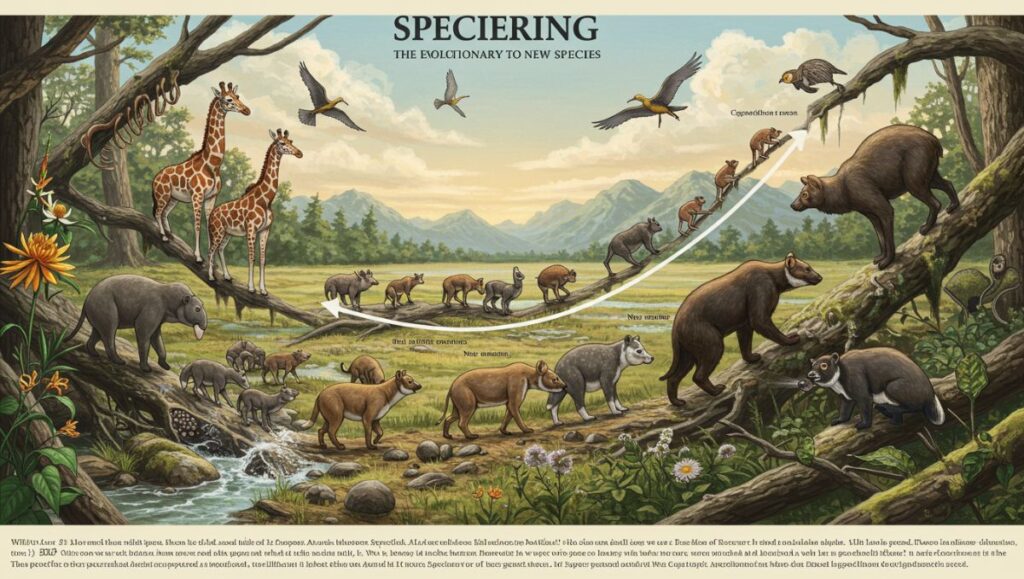Speciering is a fascinating process that shapes the rich tapestry of life on our planet. It’s how new species arise, adapting and evolving to survive in their unique environments. Think about it—each time we encounter a new plant or animal, there’s a story behind its existence. This journey of transformation and diversification reveals the incredible power of nature’s creativity.
Understanding speciering opens up a world of questions: What triggers these changes? How do different species interact as they emerge? And what role does humanity play in this intricate dance of life? Dive in with us as we explore the mechanisms behind speciation, witness it unfold in nature, and consider its implications for biodiversity. The saga of life continues to amaze us as we unravel the secrets nestled within each branch on the evolutionary tree.
What Causes Speciation?
Speciation occurs when populations of a species become isolated and diverge over time. This isolation can happen in various ways, such as geographical barriers like mountains or rivers. Once separated, these groups face different environments and pressures.
Genetic mutations play a crucial role. Over generations, these changes accumulate, leading to distinct traits that adapt to local conditions. Natural selection reinforces this divergence by favoring individuals better suited for their specific habitats.
Behavioral differences also contribute significantly. Mating rituals can evolve differently among isolated groups, preventing them from interbreeding even if they come into contact again.
Environmental factors are key players too. Changes in climate or food sources force adaptations that may not align between the two evolving populations.
These combined elements create a fertile ground for speciation, transforming once-unified species into unique entities capable of thriving in diverse ecosystems.
Types of Speciation
There are several fascinating types of speciation, each with its unique mechanisms and outcomes. One prominent type is allopatric speciation. This occurs when populations become geographically isolated, leading to distinct evolutionary paths.
Another interesting category is sympatric speciation. Here, new species arise within the same geographic area, often due to behavioral changes or ecological niches that split over time.
Parapatric speciation also plays a role in this process. It happens when neighboring populations evolve into separate species while still being in contact along a common border.
Peripatric speciation involves small populations on the edges of a larger population’s range diverging significantly. Each form highlights how varied conditions can foster the rich tapestry of life we observe today. The diversity seen across ecosystems owes much to these different pathways of evolution.
Observing the Process of Speciering in Nature
Observing speciering in nature is a fascinating endeavor. It reveals how life adapts and evolves over time. One of the best examples can be found in Darwin’s finches on the Galápagos Islands. Each species has evolved unique beak shapes to utilize different food sources.
Another striking example occurs with cichlid fish in African lakes. These fish exhibit an incredible range of colors and forms, driven by their specific habitats and mating preferences.
In isolated ecosystems, like islands or mountain ranges, we often see rapid changes occurring among populations. This geographic isolation fosters distinct traits as natural selection takes hold.
Scientists utilize genetic analysis to trace these evolutionary paths, uncovering relationships between species that were once thought unrelated. By studying these processes closely, we gain invaluable insights into the complexity of life on Earth and the intricate dance of adaptation that leads to new beginnings in evolution.
Human Impact on Speciering
Human activity profoundly influences speciering across the globe. Urbanization, agriculture, and deforestation fragment habitats. Many species struggle to adapt to these rapid changes.
Pollution plays a critical role as well. Chemicals released into ecosystems can disrupt reproductive processes and lead to genetic mutations. This destabilization may result in new forms of life emerging under stress or extinction for those unable to adapt.
Climate change is another significant factor driving this process. As temperatures rise, species are forced to migrate or adjust their behaviors. In some cases, they evolve quickly enough to survive; in others, they fall victim to the changing environment.
Additionally, invasive species introduced by humans often compete with native populations for resources. This competition can push local species towards unique adaptations—or even extinction—altering the path of evolution.
The complex web of human impact challenges natural selection’s course while highlighting our responsibility in preserving biodiversity.
The Role of Speciering in Biodiversity
Speciering plays a critical role in maintaining biodiversity. Each new species that emerges adds complexity to ecosystems, enhancing their resilience and stability. This diversity allows environments to adapt better to changes and stresses.
Newly formed species often occupy unique niches. They contribute distinct functions within their habitats, from pollination to nutrient cycling. These interactions create intricate webs of life that support various organisms.
Moreover, speciation can drive evolutionary innovation. As populations adapt over time, they develop unique traits suited for specific conditions. This process enriches genetic variation, which is vital for the survival of all species within an ecosystem.
Human activities pose threats to this natural process by disrupting habitats and accelerating extinction rates. Protecting environments allows speciering to occur organically, fostering robust ecosystems rich in diversity and ecological balance.
Conclusion
Understanding speciering gives us insight into the intricate dance of life on Earth. It highlights how species adapt, evolve, and sometimes diverge under various environmental pressures. The processes responsible for this evolution are diverse and fascinating, ranging from geographic isolation to genetic mutations.
As we observe speciation in nature, we witness the delicate balance of ecosystems being shaped over time. Human activities can disrupt these natural processes, often leading to a loss of biodiversity that has far-reaching consequences for our planet’s health.
The ongoing study of speciering reveals not only the wonders of evolutionary biology but also emphasizes our responsibility to protect endangered species and their habitats. Every small effort counts in preserving the rich tapestry of life around us. By keeping an eye on how new species emerge and thrive—or struggle—we gain valuable knowledge about our environment.
Appreciating speciering enhances our understanding of life’s complexity and interconnectedness. Embracing this knowledge might just inspire actions that ensure a vibrant future for all living beings on Earth.






